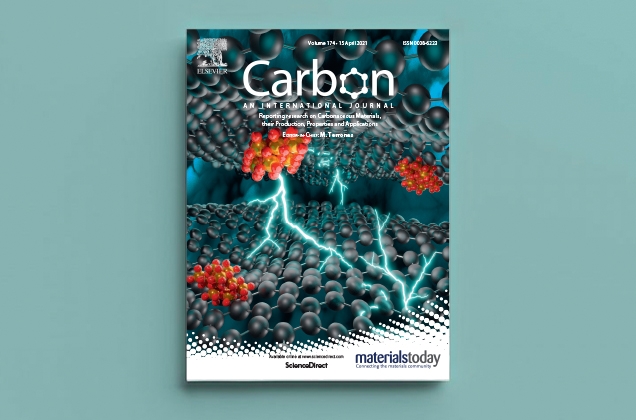22/02/2021
The study titled "High stability graphene oxide aerogel supported ultrafine Fe3O4 particles with superior performance as a Li-ion battery anode" by Assoc. Prof. Dr. Alp Yürüm from Sabancı University Nanotechnology Research & Application Center and Sabanci University Faculty of Engineering and Natural Sciences Vice Dean Prof. Dr. Selmiye Alkan Gürsel, Buse Bulut Köpüklü, and Dr. Adnan Taşdemir from Sabanci University will be featured on the April 2021 cover of the Carbon journal.

Assoc. Prof. Dr. Alp Yürüm says, "As you all know, with every new portable electronic device and electric vehicle released, we continuously need better performing batteries. The current Li-ion battery technology materials reach a limit. For that reason, we focused on a new generation material; magnetite nanoparticles. In the featured study, we developed Li-ion battery anodes consisting of magnetite and graphene. The magnetite nanoparticles developed in the study showed almost six times greater capacity than commercial anode materials."
Prof. Dr. Selmiye Alkan Gürsel adds, "Although magnetite has a good capacity, using it alone results in a failed battery after a few cycles. We synthesized the magnetite nanoparticles in a graphene aerogel. This very light and porous carbon structure surrounds the magnetite nanoparticles and conserves the capacity for hundreds of cycles."
The first author, Materials Science and Nanoengineering Ph.D. candidate, Buse Bulut Köpüklü says, "The Carbon journal is one of the most important periodicals in the materials science field. We are so proud to have published our research in this journal. The fact that our work was selected for the Journal's cover also made us delighted. We have been working on this project for more than a year. During battery operation, the fundamental problem of magnetite, a transition metal oxide, is its pulverization and subsequent detachment from the electrode. By incorporating these particles within the graphene-based aerogel, we have effectively restricted such material losses. The particles that become quite small during cycling remain at the electrode and therefore increase the electrode performance. The graphene also serves to improve the electrical conductivity of the material.". Buse Bulut Köpüklü is currently on a collaborative study at Münster University Battery Research Center to further develop new generation batteries in the scope of her Ph.D. studies. Our Materials Science and Nanoengineering graduate, Dr. Adnan Taşdemir, contributed to this research during his doctoral studies.
The first author, Ph. D. student, Buse Bulut Köpüklü says, "The Carbon journal is one of the field's most important publications. While only getting published in this journal is a big deal, being on the cover is incredible!”. She was working on this material for more than one year, and on the study, she adds, "During the battery operation, transition metal oxides like magnetite has pulverization problem. Graphene aerogel ensures stable attachment of the particles to the surface while also conducting the electricity". She is currently on a collaborative study at Münster University to further develop these new generation batteries. Dr. Adnan Taşdemir contributed to the synthesis of graphene used in the study.
The illustration used on the cover demonstrates the synergistic effect between the high-capacity magnetite and the graphene aerogel, which leads the hybrid material to outperform as an anode in Li-ion batteries. The magnetite particles' distribution inside the graphene sheets restricts the detachment of these particles from the electrode by pulverization. At the same time, graphene also enhances the electronic conductivity of the structure.
The Carbon journal is a multidisciplinary, high-impact (8.821) journal specializing in carbon materials published by Elsevier. This highly reputable journal is among the top 10% of the Scopus list. Typical examples of the carbon compounds published are carbon nanotubes, carbon nanofibers, graphitic structures, glass carbons, and graphene-based materials. In the journal, various applications of these materials can be seen. Among these applications, medicine, catalysis, electronics, environment, and energy storage/conversion are the most popular ones.
Publication doi: https://doi.org/10.1016/j.carbon.2020.12.049
Link: https://www.sciencedirect.com/science/article/abs/pii/S0008622320312264


